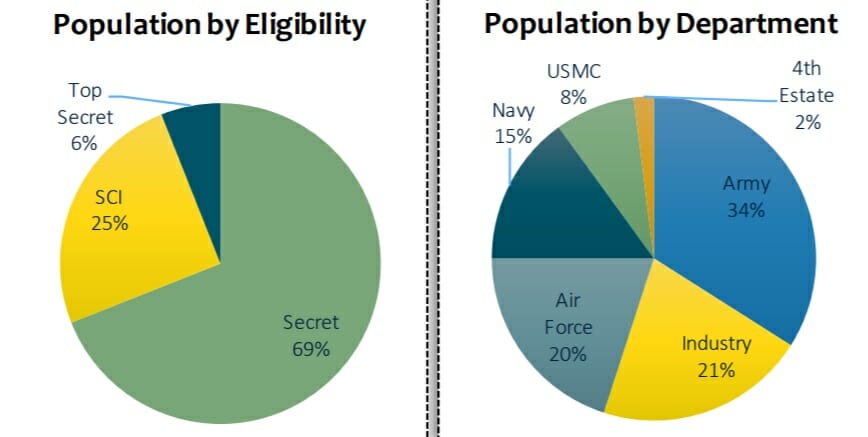The Defense Counterintelligence and Security Agency (DCSA) continues to make progress on security clearance processing times and enrolling new applicants into its Continuous Evaluation (CE) program. In numbers released for the National Industrial Security Program Policy Advisory Committee (NISPPAC), DCSA shows 2.2 million total security clearance holders enrolled in CE – that’s nearly half of the total security cleared population, and over two-thirds of the DoD clearance population, based on the most recently released figures (the Office of the Director of National Intelligence has not made a version of its annual report on security clearance determinations releasable since FY 2017).
As of 2017, the number of individuals with security clearance eligibility was just over 4 million, with 3.4 million of those individuals being DoD clearance holders. With today’s CE enrollment figures at 2.2 million, that means the CE rollout is well underway. If you have an active security clearance and you’re not currently enrolled in CE, you likely soon will be.
Who is Enrolled in CE?
Of those enrolled in CE currently, 69% are Secret clearance holders, and 31% are TS or TS/SCI security clearance holders. Within the DoD population, 21%of those enrolled in CE are industry, 34% are Army, 20% are Air Force, 15% are Navy and 8% are Marines. Two percent are DoD Fourth Estate members, which includes members of the Joint Staff, Office of the Secretary of Defense, and those organizational entities that aren’t in the military departments or combatant commands.

DCSA continues to highlight the effectiveness of finding potential issues before a traditional Periodic Reinvestigation (PR) would have identified them. CE alerts flag issues, on average, at seven years and one month for Secret clearance holders and two years and seven months for Top Secret clearance holders – both well earlier than the traditional five-and-ten-year reinvestigation timelines. Among the issues flagged are criminal conduct (1), financial considerations (2), alcohol consumption (3), and drug involvement (4). It’s worth noting that just because an issue is flagged under CE, doesn’t mean it triggers a security clearance denial or Statement of Reasons. CE alerts trigger a review, which may or may not trigger an investigation, which then may or may not result in a SOR.
The rapid advancement of CE over the past year has been possible based on improvements in the National Background Investigation Services(NBIS). While 2019 saw relatively flew applicants enrolled in CE, 2020 has ushered in a significant wave of new enrollees. Thus far, 87,803 security clearance PRs have been deferred into the CE program – that’s 87,803 PRs that didn’t need to begin, thus opening up investigative time and resources to allow DCSA to eliminate the clearance backlog and improve timeliness.
CE vs. CV
The terms CE and Continuous Vetting (CV) are often used interchangeably, but are both defined specifically in the Executive Orders that codify security clearance policies. As the DCSA website states, “Per EO 13764, CE will evolve into the Continuous Vetting (CV) model in support of Personnel Security Clearance (PCL) reform efforts.”




